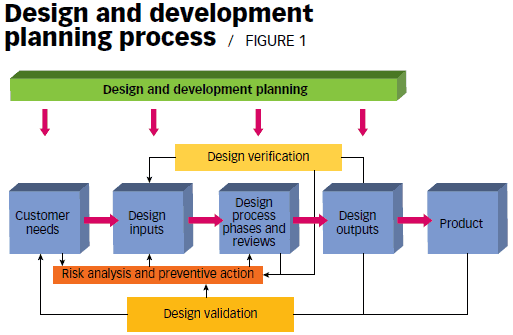While watching this week's lecture on design control, I tried to figure out the main difference between Design Verification and Design Validation. Both are used to make sure that the design outputs align with the design inputs. They both must also be documented in the Design History File (DHF). Why are these two sections separate though because they seem to share similar purposes. Hopefully someone can clarify this with more details. Thank you!
Design Validation decides whether you are building the right product. Validation is the method involved with checking whether the determination catches the client's prerequisites, while verification is the most common way of making sure that the product meets particulars. Verification incorporates every one of the exercises related to delivering excellent programming.
Design Verification is a method to confirm if the output of a designed software product meets the input specifications by examining and providing evidence. The goal of the design verification process during software development is ensuring that the designed software product is the same as specified.
While watching this week's lecture on design control, I tried to figure out the main difference between Design Verification and Design Validation. Both are used to make sure that the design outputs align with the design inputs. They both must also be documented in the Design History File (DHF). Why are these two sections separate though because they seem to share similar purposes. Hopefully someone can clarify this with more details. Thank you!
The main difference between the two is that verification is compare the beginning to the end. Did you accomplished the things you stated at the begin. While validation is more so does this production accomplish the goal it was intend before. It may not work the same way but it does do what it is suppose to do.
It confused me at first, but I figured out the difference by remembering the different results of Validation and Verification want. Verification is a process to know do you do the thing with the correct method. The validation and verification are similar to the coding project to me. Verification is equal to checking if the coding script is correct. And the validation is the same as checking if the game is running as expected. In other words, verification is a process that ensures the function between input and output is correct. And the validation is more like checking whether the answer corresponds to the beginning question.
As everyone else has said, while both processes are testing the product, they each test different aspects. Verification directly tests the product's specifications, for example, the color or size of the product. Validation is more focused on whether the product meets the user needs. For example, can the product be operated easily by the user. Since they each test different aspects of the product, different testing methods would be used for each process.
Validation can be defined as the process of evaluating a product to determine if the device satisfies the user requirements. In other words, Validation intends to fulfill the intended wishes of the user when placed under intended usage whereas Verification intends to check if the requirements of the phases are met. Therefore, verification is matching all your outputs to the input, while validation is ensuring the product does what the customer ask for. And that can be done through in vitro and clinical tests.
Q: Why are these two sections separate though because they seem to share similar purposes
A: This was a similar question that I had regarding design verification and validation. Both served the same purpose as well as underwent similar processes in order to achieve the desired result. What I considered a major difference between the two would be the true words "verification" and "validation". In the design verification, the sole premise is the checking portion of the PDCA. That involves making sure that the input matches the output. During the verification report, researchers take all the test results and put them in the report itself, and they show everything that passed or failed in the designing of the product. In the design validation, the intent is that the input matches what the demographic needs and what the intended use of the product has is true to form. This involves the testing phase of the product itself. The other point that sets these two apart is that the validation process is not truly necessary if the verification process is done correctly. The validation of the device would entail using the device on living people, a cadaver, or having a physician try to use the product.
Design verification ensures that your design outputs match your design inputs. To put it another way, did you design the device correctly? Validation is establishing that the device's design fulfills the user needs and intended usage.

